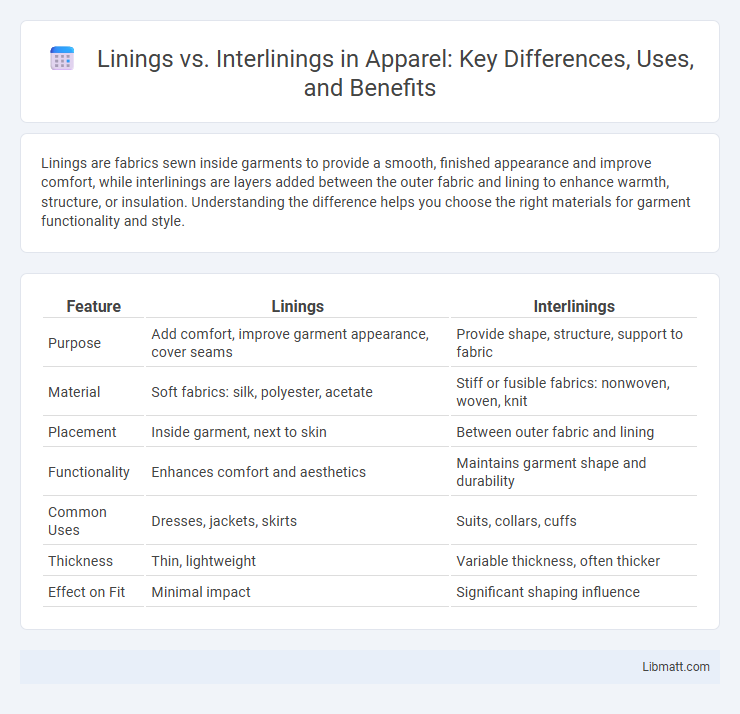Linings are fabrics sewn inside garments to provide a smooth, finished appearance and improve comfort, while interlinings are layers added between the outer fabric and lining to enhance warmth, structure, or insulation. Understanding the difference helps you choose the right materials for garment functionality and style.
Table of Comparison
| Feature | Linings | Interlinings |
|---|---|---|
| Purpose | Add comfort, improve garment appearance, cover seams | Provide shape, structure, support to fabric |
| Material | Soft fabrics: silk, polyester, acetate | Stiff or fusible fabrics: nonwoven, woven, knit |
| Placement | Inside garment, next to skin | Between outer fabric and lining |
| Functionality | Enhances comfort and aesthetics | Maintains garment shape and durability |
| Common Uses | Dresses, jackets, skirts | Suits, collars, cuffs |
| Thickness | Thin, lightweight | Variable thickness, often thicker |
| Effect on Fit | Minimal impact | Significant shaping influence |
Understanding Linings and Interlinings
Linings and interlinings are essential components in garment construction, each serving distinct purposes: linings provide a smooth, comfortable finish inside the garment while enhancing durability, whereas interlinings add structure, insulation, and shape between the outer fabric and lining. Understanding these layers helps you select the right materials to improve the garment's fit, warmth, and overall quality. Proper use of linings and interlinings can significantly impact your clothing's performance and aesthetics.
Key Differences Between Linings and Interlinings
Linings are fabric layers sewn inside garments to enhance comfort, appearance, and durability, while interlinings are inserted between the outer fabric and lining to provide additional structure, insulation, or stiffness. Linings primarily improve breathability and smoothness against the skin, whereas interlinings contribute to shape retention and garment stability. The choice between linings and interlinings depends on the desired garment functionality, fabric type, and design requirements.
Functions of Linings in Garments
Linings in garments primarily provide a smooth inner surface that enhances comfort and helps the garment maintain its shape. They protect the outer fabric from body oils and sweat, increasing the durability of the garment. Linings also improve the overall appearance by concealing seams and construction details.
Purpose and Benefits of Interlinings
Interlinings provide structural support, enhancing the garment's shape and durability by reinforcing seams, collars, and cuffs. They improve fabric stability, preventing stretching and wrinkling, which extends the garment's lifespan. Interlinings also contribute to thermal insulation and added comfort by offering an extra layer between the outer fabric and skin.
Material Choices for Linings and Interlinings
Linings are typically made from smooth, lightweight fabrics such as polyester, acetate, or silk to improve garment comfort and appearance, while interlinings use stiffer materials like fusible or sew-in nonwovens, cotton, or wool blends to provide structure and support. Natural fibers in linings enhance breathability, whereas synthetic options offer durability and moisture resistance. The selection of lining and interlining materials directly influences garment fit, drape, and longevity.
Common Applications in Fashion and Upholstery
Linings provide a smooth, finished interior surface in garments and upholstery, enhancing comfort and appearance, while interlinings add structure and insulation between fabric layers. In fashion, linings are commonly used in jackets, skirts, and dresses for breathability and ease of wear, whereas interlinings reinforce collars, cuffs, and tailored suits for durability and shape retention. Upholstery applications utilize linings to protect padding and improve fabric longevity, with interlinings offering additional support for cushions and padded furniture, ensuring your items maintain form and comfort over time.
Pros and Cons: Linings vs Interlinings
Linings enhance the comfort and aesthetic appeal of garments by providing a smooth interior finish, but they can add weight and increase cost. Interlinings offer structural support and shape retention, improving garment durability while potentially reducing breathability. Your choice depends on whether you prioritize comfort and appearance (lining) or garment stability and form (interlining).
Factors to Consider When Choosing Between Linings and Interlinings
Choosing between linings and interlinings depends on factors such as the desired garment structure, warmth, and comfort. Linings provide smoothness and help shape the outer fabric, while interlinings add stiffness or insulation depending on their material. Assessing your garment's purpose and fabric weight ensures the right balance between flexibility and support for optimal wearability.
Care and Maintenance Tips
Linings require gentle washing and low-heat ironing to maintain their smooth texture, while interlinings need careful handling to preserve their structural support without distortion. Avoid harsh detergents and always follow the garment's care label to extend the longevity of both components. Proper storage in a cool, dry place prevents fabric deterioration, ensuring Your clothing retains its shape and comfort.
Expert Recommendations and Best Practices
Experts recommend selecting linings and interlinings based on fabric weight, garment purpose, and desired structure to enhance comfort and durability. High-quality lining materials like acetate provide smooth texture and breathability, while interlinings such as fusible or sew-in options add stability and shape retention. Best practices include testing compatibility with outer fabrics and preferring lightweight interlinings for delicate apparel to maintain drape without bulk.
linings vs interlinings Infographic

 libmatt.com
libmatt.com